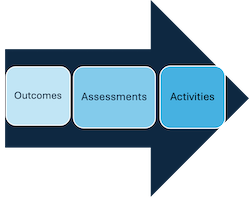24 Recommendations are tagged with "Faculty Teaching Institute"

Quick tips from the Faculty Teaching Institute about how to implement backwards design. Backwards design is a method for course planning where the instructor starts from the "end goal" or "learning objectives"--what they want their students to know--and then works backwards, designing assessment activities and learning activities that are aligned with the end goal.
Faculty Teaching Institute, backwards design, student learning outcomes

Quick tips from the Faculty Teaching Institute about how to create effective and inclusive presentations.
Faculty Teaching Institute, lecture, presentation

Quick tips from the Faculty Teaching Institute about how to support students in reading text effectively.
Faculty Teaching Institute, reading, Just-in-time teaching

Quick tips from the Faculty Teaching Institute about how to run whole-class discussions. Whole class discussions are an opportunity for community dialogue. Below are practices to increase the number participating, give them time to think, and make it non-threatening and inclusive.
Faculty Teaching Institute, class discussion

These quick tips from the Faculty Teaching Institute can be used with think-pair-share (TPS), where students think on their own, pair to talk to a neighbor, and share with the whole class, with or without polling.
Faculty Teaching Institute, CAE Think-Pair-Share

Quick tips from the Faculty Teaching Institute about how to support students with quantitative problem solving
Faculty Teaching Institute, quantitative, problem solving

Quick tips from the Faculty Teaching Institute about how to make large classroom learning environments more effective.
Faculty Teaching Institute, large classes, active learning

These quick tips from the Faculty Teaching Institute can be used to make labs more effective.
Faculty Teaching Institute, labs

Quick tips from the Faculty Teaching Institute about how to motivate your students to learn.
Faculty Teaching Institute, motivation, productive engagement, student buy-in

Quick tips from the Faculty Teaching Institute to help you get started designing a new course.
Faculty Teaching Institute, course design

Quick tips from the Faculty Teaching Institute to help make your class more inclusive.
Faculty Teaching Institute, inclusive teaching, inclusion, equity

Quick tips from the Faculty Teaching Institute to help you use simulations and demonstrations more effectively.
Faculty Teaching Institute, simulations, demonstrations

Quick tips from the Faculty Teaching Institute about how to structure group work.
Faculty Teaching Institute, group work

These quick tips from the Faculty Teaching Institute can help facilitate group work.
Faculty Teaching Institute, facilitation, group work

Quick tips from the Faculty Teaching Institute about engaging students on the first day and throughout the term.
Faculty Teaching Institute, productive engagement, active learning, first day of class, student buy-in

Quick tips from the Faculty Teaching Institute about using assessment to improve your classes.
Faculty Teaching Institute, assessment

These are quick tips from the Faculty Teaching Institute for using summative assessments (primarily exams and quizzes) in ways that will assess what you value in student learning while being compassionate, clear, and fair, and facilitating student learning.
Faculty Teaching Institute, summative assessment, exams

These are quick tips from the Faculty Teaching Institute for developing homework and quizzes to learn about student thinking. Homework and quizzes are useful tools for students to practice new concepts and skills and get feedback. In-class formative assessments (Classroom Assessment Techniques, or CATs) give on-the-spot feedback to students and teachers.
Faculty Teaching Institute, formative assessment, homework

This Expert Recommendation provides a quick overview of student-centered instructional techniques from the Faculty Teaching Institute. Student-centered instruction places the focus on the learner (rather than the instructor), emphasizing student ideas and thinking; it includes but is not limited to active learning.
Faculty Teaching Institute, active learning

Formative assessment is low-stakes, ongoing assessment to monitor students' learning and give them feedback during instruction. Classroom assessment techniques (CATs) are classroom activities to quickly gauge student understanding.
Faculty Teaching Institute, formative assessment

Educational technology is the use of computer software and hardware for learning purposes.
Faculty Teaching Institute, educational technologies

Teaching reflection involves considering your teaching experiences, learning from the outcome, and planning how to better approach similar situations in the future. This Expert Recommendation will give an overview of the constellation of teaching reflection strategies and some reflection prompts.
Faculty Teaching Institute, reflection strategies

Summative assessment is assessment to evaluate student learning at the end of instruction. Summative assessment is often high-stakes.
Faculty Teaching Institute, summative assessment

These quick tips from the Faculty Teaching Institute can be used to improve grading in your classes.
Faculty Teaching Institute, grading, assessment